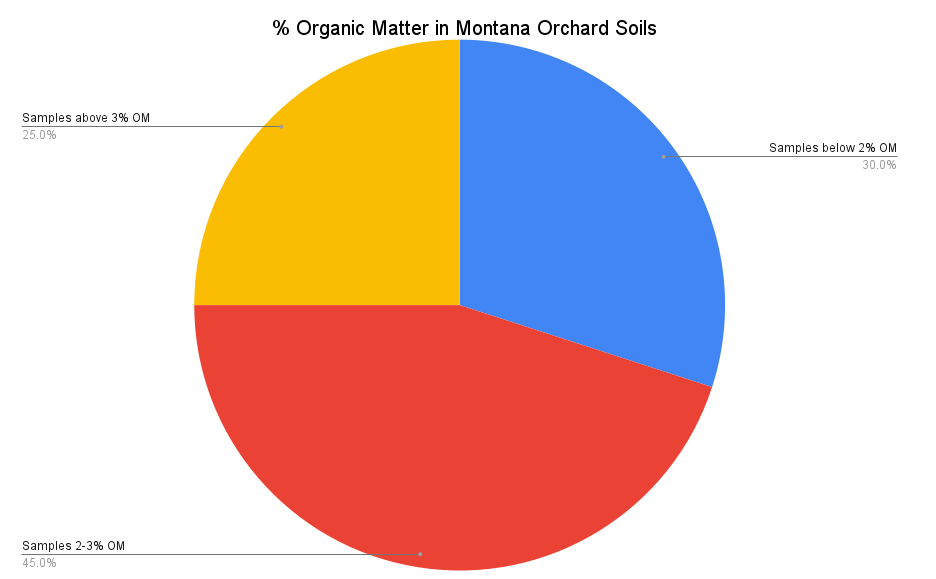Montana Orchard Nutrition Survey Results
Project Overview
In spring/summer 2021, with funding from a WSARE PDP grant, WARC staff assisted 23 growers with orchard soil and foliar sampling. The purpose of this sampling was to help individual growers develop a baseline understanding of their orchard nutrition needs and determine what nutrient deficiencies or imbalances were present in Montana orchards across the state.
Twenty-three Orchards were surveyed in the Bitterroot, Missoula, Flathead, Clark’s Fork, Ruby and Gallatin Valleys as well as the Hi-Line. In some cases multiple samples were collected from orchards when potential nutrient deficiencies were noted by growers. A total of 30 foliar samples and 22 soil samples were taken. Spectrum Analytics was used as both the soil and foliar testing lab as they have robust experience with analyzing foliar apple samples and several standards to use for comparison. In cases where orchards had a recent soil sample these were used in place of additional sampling. Orchards also received a soil probe for their personal use which can also be shared with neighboring orchards to promote future sampling and monitoring of orchard nutrition.
While sample results varied from orchard to orchard and even with in orchard, soils tended to have elevated pH levels; soil deficiencies were rare for phosphorus (P), magnesium (mg) and manganese (Mn); the most common foliar deficiency was boron (B); and in some orchards, despite high levels of soil calcium (Ca), potassium (K) and zinc (Zn) foliar samples were deficient indicating uptake issues. Full results are summarized below.
Soil results
Orchard soils were sampled for pH, %organic matter (OM), CEC and primary micro- and macronutrients. Average pH was 7.0, however, as expected a majority of orchards had pH’s above 7.2 which is considered high for an orchard. Somewhat surprisingly, orchards surveyed in the Bitterroot Valley had significantly lower soil pH then other regions across the state (P=.002), see Figure 1). On average % soil organic matter was 2.5%, ranging from 1.0-4.1% with 45% of samples in the 2-3% organic matter range (see Figure 2). There was no significant difference in % organic matter based on region. Both pH and % organic matter are typical for Montana soils which tend to have higher pH and low organic matter on account of soil parent materials, soil age and climate.
In terms of available nutrients, most orchard soils were deficient in boron (84%), sulfur (55%) and copper (27%). Additional deficiencies were reported in phosphorus, zinc, iron and manganese. A majority of orchards also had high levels of soil magnesium (50%) and calcium (61%) with some orchards also reporting elevated phosphorus, potassium, zinc and manganese. The high pH, low organic matter and calcareous qualities of Montana soils likely influence the low availability of these micronutrients. Elevated levels of nutrients may be attributed to orchard management including fertilizer or pesticide inputs containing these nutrients, or in some cases parent material and/or irrigation water.

Figure 1. Average pH of Montana Soils. Bitterroot Valley orchards had significantly lower soil pH's than other orchards across the state (P=.002). On average Bitterroot orchard soils had a pH of 6.4, with other regions averaging 7.2-7.6. Individual orchard soil pH ranged from 5.9-8.0.

Plant tissue results
Plant tissue results are better indicators of orchard nutrition than soil as they reflect what the tree is actually getting from soil and fertilizers. Of surveyed orchards, all but one orchard was deficient in one or more nutrients with most orchards deficient in two or more. The greatest number of deficiencies were in Ca (73%), Zn (65%), B (47%) and Cu (43%), with additional deficiencies in K, N and Mg. Some samples also had elevated levels of nutrients the most frequent being N (13%) followed by P, K, B and Fe. Some orchards also had high levels of Mg, Mn, S and Zn but these incidents were rare occurring in just 4% of samples. Again these elevated levels are likely due to orchard management, affirming the importance of continual monitoring of tree nutrition to avoid both deficiencies and toxicities.
Discussion
This survey confirmed that many Montana orchards must overcome high pH and low organic matter soils to supply trees with important nutrients. Foliar results confirmed that Zn and B are micro-nutrients Montana growers should supplement and carefully monitor. Additionally, despite elevated levels of Ca, Montana orchards had consistently low levels of foliar Ca. This is a common experience of growers across the West who must manage Ca nutrition by addressing tree vigor, irrigation practices and crop load in addition to providing foliar sprays as high soil Ca does not guarantee plant uptake.
One surprising result of this survey was the number of orchards deficient in foliar Cu (43%). While results indicating low soil Cu are not necessarily surprising, Montana orchards are often treated with copper sprays to prevent fire blight. This is typically enough to supply the needs of the trees, as well, however this might not be the case for all orchards given these results.
It is important to remember that tissue analysis is based on standards as reported typically in orchards around the world and for specific varieties. Few if any of the cultivars grown in many Montana orchards are well represented by labs so general standards were used for this project. While tissue samples are a good indication and provide a record of plant nutrition, monitoring vegetative growth, yield, and fruit quality are also important indicators of orchard nutrition. Year to year changes in these factors as well as careful record keeping of soil and foliar samples will help growers better monitor their orchard nutrition and develop customized plans for their operation. Results from this survey were used to inform a resource on Montana Orchard Nutrition as part of WARC's online Guide to Growing Apples in Montana. Visit this resource for more information on specific nutrients, promoting nutrient cycling and uptake and applying fertilizers and foliar sprays.

